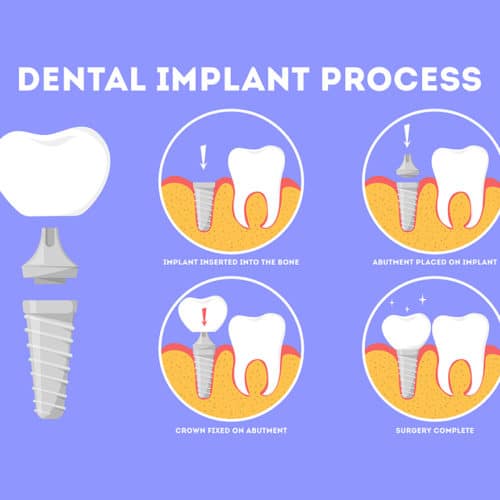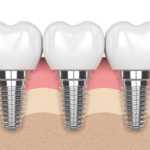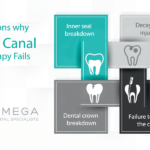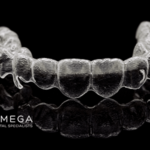Dental Implant Surgery Step By Step

In most cases, patients can expect outpatient surgery when having a dental implant procedure performed. That said, here are the basics when it comes to dental implant surgery and what the patient can expect. This type of surgery is usually performed in stages. For example, the first stage typically involves removing the damaged tooth. The bone is carefully prepared for surgery. The preparation may sometimes include bone grafting as needed. Once the jawbone has healed, the oral surgeon is then able to place dental implant type metal posts directly into the jawbone.
Table of Contents
Healing After Implant Surgery
Following this stage of dental implant surgery, the patient may go through an extended period of healing as required. This can easily last up to several months. It should be noted that each patient is unique and different, and as such, healing can vary substantially. The next stage in the process involves the oral surgeon placing what is known as an abutment. This is simply an extension of the dental implant metal post that will allow for the easy acceptance of several different types of oral appliances or artificial teeth. Once the soft tissue has had time to heal, your dental care provider will then make molds of your teeth. Molds are also made of the jawbone as needed. Finally, your dentist will place the final tooth, multiple teeth, or dental appliance depending on your specific dental needs.
Powerful Chewing Forces
The patient should understand that the entire dental implant process could easily take up to several months from start to finish. Much of the time involved in the process is allocated for healing and waiting for the growth of new bone within the patient’s jaw. A critical aspect of this type of surgery is that when bone grafting is required, the process can be long and be somewhat more complicated. Bone grafting is usually implemented when the jawbone is not thick enough or maybe too soft for dental implant surgery. The patient should understand that powerful chewing forces within the mouth produce substantial pressure on the bone. The bone must be healthy and allow for a stable base for dental implants.
Bone Grafting
When the bone grafting has required, a piece of bone is removed from either the patient’s jaw or another part of the body. For example, the hip is often targeted as a preferable site for bone grafting needs. In other cases, artificial bone substitute or animal-derived bone material can be used. Once a suitable bone material has been chosen, it can then be transplanted directly into the jawbone. Most patients only require minor bone grafting, which can be performed during dental implant surgery. The determining factor about how the oral surgeon proceeds are always the overall condition of the jawbone.
Implant Placement
Once the oral surgery is underway, the oral surgeon will place the dental implant by making a small cut to open the gum to expose the jawbone. The next step requires that the oral surgeon drill placement-holes directly into the bone where the actual dental implant metal posts will be positioned.
Temporary Restoration
The metal posts are implanted deep within the bone to ensure secure, firm, and stable placement. Once the initial surgery has been completed, the patient will have a noticeable gap in teeth or multiple gaps, depending on the number of teeth that are missing. The oral surgeon will place a temporary or partial denture to create a healthy appearance until the final restorative work can be completed. About bone grafting and dental implants, once the implant post has been securely placed into the jawbone, the jawbone will then take several months to grow and unite with the dental implant surface. This ultimately provides a solid base for final restorative work that includes an artificial tooth or teeth.
Full Oral Functionality
In essence, a dental implant is intended to work exactly like a tooth by providing a secure and firm base so that patients enjoy standard oral functionality as well as an attractive outward appearance. Patients should also understand that they have choices when it comes to artificial teeth following dental implant surgery. After the gums have had a few weeks to heal, an artificial tooth can then be attached as required. Your dental care provider will make impressions of your mouth and any existing surrounding remaining teeth. These impressions are used to create a restorative crown that ultimately looks exactly like your real teeth.
Snap Securely Into Place
Finally, patients will ultimately have a choice regarding removable as opposed to fixed artificial teeth. In some situations, a combination of both may be advised. Removable false teeth are similar in many ways to conventional removable dentures. The denture appliance is configured on a metal frame that is ultimately attached directly to the dental implant abutment. It is designed to snap securely into place within the mouth and can be conveniently removed as necessary for routine cleaning or repair.
Conversely, a fixed type of artificial tooth is permanently attached to the dental implant abutment. This type of arrangement means that the restorative work cannot be removed for cleaning, sleeping, or repair. Dental implant surgery is an excellent option for many patients today. Talk with your dental care provider for more information on implants.
Related articles:
- 9 Things You Need to Know About Dental Implants in Houston
- 10 Things You Need to Know About Dental Implant in Houston
- Dental Implant Benefits
- Are Dental Implants Right for You?
- What you need to know about Omega Dental Specialists Implant Center





